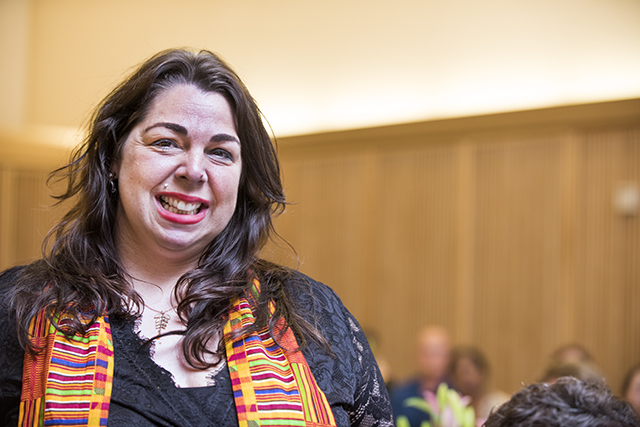
To help alleviate homelessness among students, who face a housing shortage and other barriers, Humboldt State has created a new position: an off-campus housing liaison. It’s the first position of its kind at the University and in the 23-campus California State University system.
Social Work graduate student Chant’e Catt, who experienced homelessness when she first transferred to Humboldt State, was hired to help students learn about housing rights, how to be a good tenant, and more. She has worked with more than 300 students since HSU established the position in January 2018.
Creation of this role is one of several measures designed to address housing and food challenges for students. The University now provides short-term emergency housing in residence halls and emergency scholarships to help students facing homelessness afford rental deposits and other needs. HSU also offers services under the HSU Oh SNAP! Student Food Programs.
In a recent statewide study commissioned by the California State University Chancellor’s Office, Social Work Professor Jennifer Maguire and CSU Long Beach Social Work Professor Rashida Crutchfield found troubling rates of housing insecurity among CSU students. At Humboldt State, 19 percent of students reported being housing insecure at least once in the last 12 months.
Catt was one of those students, and lived homeless for 16 weeks during her first semester at HSU, along with her young daughter, partner, and dog. Based on her experience, she co-founded the Homeless Student Advocate Alliance (HSAA), a student club that advocated and supported student housing. As a result of the club’s work, the housing liaison position was created and Catt was hired to fill the position.
In a report Catt prepared earlier this year for Housing & Residence Life, she identifies barriers student face, including: a shortage of housing due to the local and student populations, marijuana grow houses, and vacation rentals; racial inequality and discrimination faced by students of color; access to a co-signer; and the difficulty of touring and securing housing for students not currently in the area.
Students who get help arrive at her office in many ways: from the recommendation of campus offices like C.A.R.E., C.A.P.S., word of mouth, the HSAA, and more.
When someone reaches out, Catt begins by talking with them so they understand the local housing market and unique difficulties students face. She also sends them an intake survey, which helps her understand their particular situation. Do they have pets? Do they have enough money for a deposit?
She’ll then provide students a variety of resources depending on their needs: books and resources for renter’s rights, recommendations for lawyers on tenant issues, mentorship on applications, and advice on how to be a good tenant a good roommate, and more.
Catt also maintains a list of current housing availabilities. In her advocacy work and role at HSU, she’s developed many contacts in the community, including landlords. “Community members tend to call me with a lot of resources,” she says.
Catt also conducts outtake surveys, asking students to share how much she was able to assist, and if the student’s issues were solved. These responses have helped her and Housing determine ways to improve their services.
In addition to her day-to-day work, Catt is working with three other Social Work graduate students, the Office of Diversity, Equity, & Inclusion, Equity Arcata, HSU Housing, and the cities of Arcata and Eureka to develop an education program for landlords and tenants. If successful, the program will focus on equitable practices, rights and responsibilities of tenants and landlords, and more.
“The off-campus housing liaison is a good town-and-gown position,” Catt says. “The biggest issues between students and landlords began because of a lack of communication between entities. There was a lot of fingers pointing and no one taking action.”
Community education is another key to the local housing shortage. HSU and College of the Redwoods hosted a community housing summit this year to build awareness and empathy, and to support existing programs and services. Equity Arcata, an effort of the University, City of Arcata, and local businesses to address equity and inclusion issues, is a hub for local stakeholders to prioritize affordable housing.
The University is pairing homeless awareness with an overall focus on student wellbeing, supported by student wellbeing ambassadors and an interactive online map to guide students toward mental and physical health and academic success. Students can also find guidance for signing up for various types of insurance, including Medi-Cal.
Two upcoming events will highlight student housing insecurity:
The Humboldt County Homeless College Student Photovoice Project explored resiliency among local college students who experienced being homeless while attending college in Humboldt County. In collaboration with Professor Pam Bowers from Social Work, eight HSU students took photos and shared stories related to their experiences over the 2017-18 academic year. A gallery event highlights these stories and photos with the primary goal to honor student experiences, and the challenges faced in our rural community related to housing, and seek solutions through action research.
The gallery will be available throughout the month of November in the SBS building lounge.
Chant’e Catt and Masters of Social Work coordinators Kate Harris, Sonya Woody, and Ashley Bradshaw will host a Town Hall Discussion on Tuesday, Nov. 30 from 11 a.m. -1 p.m. in the Great Hall. The topic will be development of a Tenant and Landlord Education Program. The public is invited to learn about the program and give feedback. Please RSVP by Nov. 16 at 5 p.m. at housingliaison@humboldt.edu or 707.826.5509.
For information about off-campus housing resources or to reach the off-campus housing liaison, visit the Living Off Campus website.